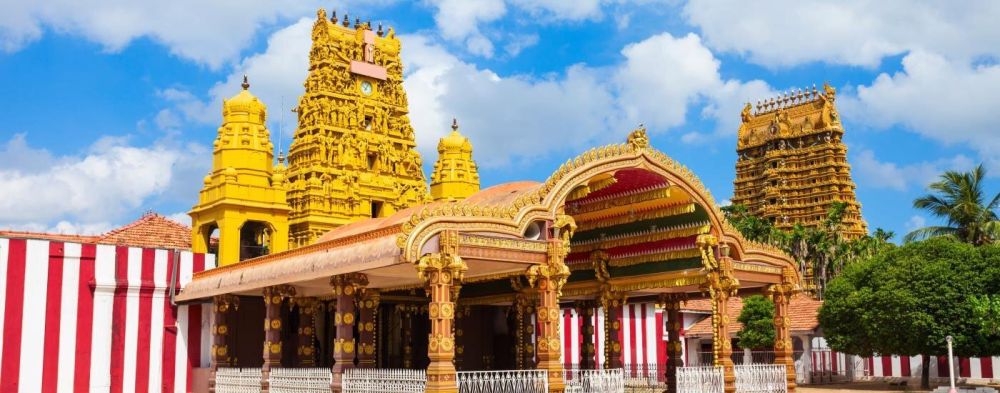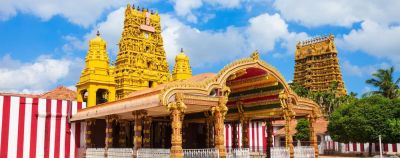

Nallur Kandaswamy Kovil is one of the most significant Hindu temples in the Jaffna Peninsula of Sri Lanka. Erected in 948 AD, this temple boasts a rich history and is dedicated to the war god Murugan. The temple is well-known for its annual festival, which takes place over 25 days during the Tamil month of Aavani (August–September). The architecture is characterized by a vibrant and colorful gopuram (tower), which is a spectacular sight to behold. While at the temple, visitors can observe various rituals and ceremonies, participate in prayers, and absorb the distinctive Tamil culture and religious practices. Respectful attire is a must, with shoulders and knees covered, as it is a place of worship.
Jaffna Fort stands as a testament to Sri Lanka's colonial history, serving as an anchor to the city's past. Built by the Portuguese in 1618 and later renovated by the Dutch, the Fort presents a fusion of colonial architectural styles. Visitors can take a walk around the ramparts and moat while enjoying views of the surrounding sea and the cityscape. Within the compounds, one can discover the remnants of the governor's residence, a church, and various administrative buildings. The Jaffna Fort has undergone restoration efforts after sustaining substantial damage during the civil conflict, but it retains an air of historical significance and offers an educational experience owing to the detailed informational placards spread throughout the site.
The Jaffna Public Library is one of the best-known landmarks in Jaffna and is of great symbolic importance to the local Tamil community. It once held the title of the biggest library in Asia, housing over 97,000 books and manuscripts before it was burnt down in 1981. Since then, it has been rebuilt and restocked, albeit not to its former glory. It remains an important institution for education and culture in the region. Visitors to the library can explore its architecture, picturesque gardens, and existing collection of books, newspapers, and periodicals. While the primary focus is on Tamil literature, it also contains English and Sinhala literary works. Many come to the library not only to read but to also contemplate the resilience of the city of Jaffna.
Casuarina Beach is one of the most beautiful and popular beaches in the Jaffna Peninsula, named after the Casuarina trees lining its shore. The beach is famous for its shallow waters and soft sands, making it ideal for swimming and sunbathing. Visitors can enjoy the serene atmosphere, take a leisurely stroll along the coast, or indulge in fresh seafood from nearby stalls. The beach's gentle and clear waters make it a favorite among families and those looking to escape the hustle and bustle of city life. Additionally, Casuarina Beach offers spectacular sunsets, providing a perfect backdrop for evening relaxation and photo opportunities.
Kantharodai, known locally as Kadurugoda, is an ancient Buddhist site located near Chunnakam in Jaffna. The area consists of a cluster of small dagobas (stupas) dating back to the Anuradhapura period when Buddhism thrived in the region. Visitors to Kantharodai will find themselves wandering among dozens of these bell-shaped structures, which are considered unique due to their size and number. Excavations have uncovered coins, Buddhist sculptures, and other artifacts here, suggesting the historical and archaeological significance of the site. Kantharodai serves as a poignant reminder of the shared multi-religious history of the region and is a must-visit for history buffs and those interested in the early Buddhist cultures of Sri Lanka.
The Keerimalai Natural Springs are freshwater springs located near the northern coast of Jaffna, close to the Keerimalai Naguleswaram temple. A high mineral content is believed to endow the waters with healing properties, which attract both locals and tourists alike. The springs are separated into two zones – one for men and another for women – to offer privacy for bathing. The natural beauty of the area is complemented by the adjacent sea, creating a peaceful and rejuvenating environment. Visitors can not only take a dip in the therapeutic waters but can also explore the nearby Hindu temple, enjoy the coastal views, and sample local snacks sold by vendors around the springs.
A trip to Delft Island, locally known as Neduntheevu, offers a unique glimpse of Sri Lankan rural life mixed with remnants of colonial history. The island is accessible via a navy-operated ferry from the Kurikadduwan jetty on Jaffna's mainland. Visitors can discover wild horses roaming freely, colonial ruins, including an old Dutch fort, and ancient Baobab trees. With its distinctive landscapes of coral walls and palmyra plantations, Delft Island provides a stark contrast to the mainland both culturally and geographically. Tourists can hire local tuk-tuks to explore the island's attractions, which include the growing Veldt, the Queen's Tower, and the Pigeon Hole natural rock formation.
No visit to Jaffna is complete without experiencing its unique and flavorsome cuisine. Jaffna's local dishes are characterized by their distinct blend of spices and use of fresh, locally sourced ingredients. Visitors can explore various restaurants and street stalls to taste an array of specialties like Jaffna crab curry, dosai (a type of crispy pancake), idiyappam (string hoppers), and the renowned Jaffna mango. Seafood lovers can enjoy fresh catches from the surrounding waters, including prawns, crabs, and fish, typically prepared with a tantalizing mix of local herbs and spices. Many eateries offer authentic Jaffna meals served on banana leaves for a traditional dining experience that engages all the senses.
The Point Pedro Market is located in the northernmost town of the Jaffna Peninsula. It is a bustling hub where locals come to sell a wide array of goods, including fresh produce, spices, handloom textiles, and traditional crafts. Visitors can immerse themselves in the vibrant atmosphere, where the lively chatter of traders and buyers creates a soundtrack to the colorful array of stalls. Exploring the market is a chance to interact with the local community, learn more about their way of life, and perhaps purchase some souvenirs or ingredients for an authentic Jaffna dish. Point Pedro Market operates daily, with the busiest days being on the weekends when the selection is at its fullest.
The Jaffna Archaeological Museum offers visitors a deep dive into the rich historical and cultural heritage of the Jaffna Peninsula. The museum showcases a diverse range of artifacts recovered from the region, including ancient pottery, coins, statues, and inscriptions. Each exhibit provides insightful context into the daily life, religious practices, and commerce of historic Jaffna. The museum building itself is a colonial-era structure, adding another layer to the historical exploration. It is well-maintained and includes descriptions in multiple languages to cater to both local and international visitors. Those interested in Sri Lanka's past will find the museum to be an invaluable resource for understanding the historical narrative of the Jaffna region.
